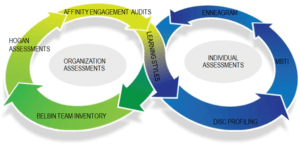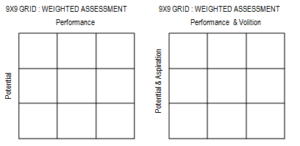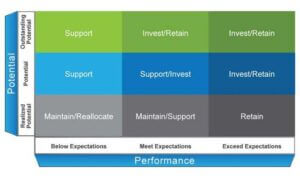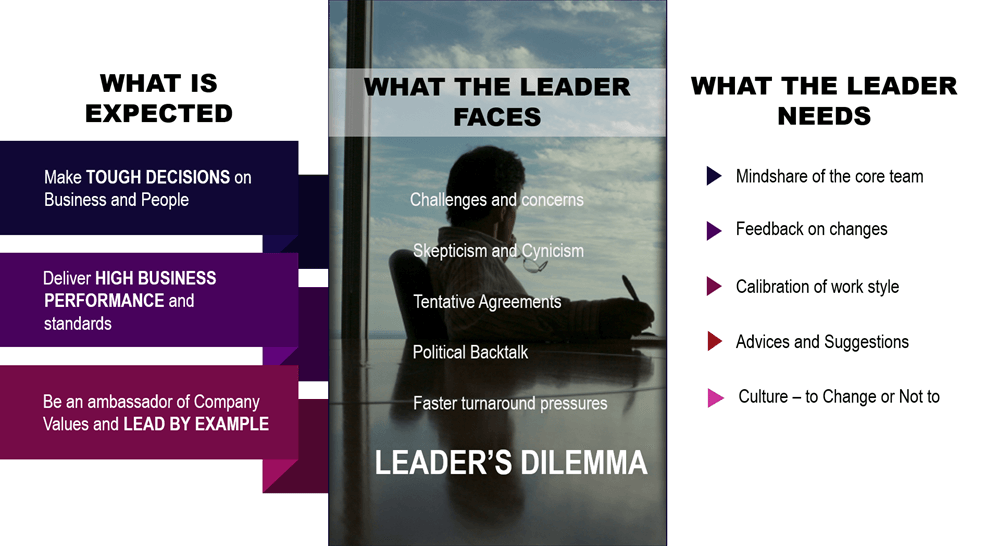LEADERSHIP TRANSFORMATION
LEADERSHIP TRANSFORMATION
exploring
- People Assessments
- Talent Grid - Leadership Succession & Pipeline
- Leadership Effectiveness Assessment
- Developing High Potentials
- Mentoring
- New Manager Assimilation
PEOPLE ASSESSMENTS
Whether you are a leader seeking more insight into yourself or an HR professional addressing some personality dynamics of a leader, team, or an employee for the purpose of selection, promotion, development, etc. we have a battery of tests to help you in your journey.

BELBIN TEAM PROFILING
The Belbin team inventory is based on a concept of Social, Thinking & Action orientation
AS A LEADER
- Do I Have TRUSTED teams?
- Are my teams high performing?
- Are my teams aligned and synergized?
According to Belbin team profiling “A team is not a bunch of people with job titles, but a congregation of individuals, each of whom has a role which is understood by other members. Members of a team seek out certain roles and they perform most effectively in the ones that are most natural to them”.
DR. R. M. BELBIN
The Belbin team inventory is based on the concept of creating a balance between three critical factors of team orientation. These three critical factors are related to Action orientation, Social orientation, and Thinking orientation. An in-depth understanding and assessment of team dynamics act as a very powerful catalyst for the Leaders to create a high-performing team based on the natural strengths of team members. This also enables Leaders to assess the demands that the organization places on their functions and invent accurate people strategies to address those demands.
HOGAN
The Motives, Values, Preferences Inventory (MVPI) is a personality inventory that reveals a person’s core values, goals, and interests
AS A LEADER
- Do I have the right values and culture within my organization?
- Am I able to drive people to their full potential?
- Do I know how, why, and when my people and leaders risk the organization?
People’s core motives, values, and interests affect every aspect of their lives, from how they behave, to the kind of atmosphere and work environment in which they feel happy and productive. Not surprisingly then culture is a by-product of the kind of people the organization is led by, the kind of people it employs, and their alignment or misalignment towards their goals i.e. the customers they serve.
Any incoherence between the stated goals and amongst the teams and leaders aiming to achieve these goals has meant catastrophic results for business viz. closure of business, poor stock market valuation, hostile acquisitions, firing of top executives, unexpected entry of competition, etc.
The Motives, Values, Preferences Inventory (MVPI) is a personality inventory that reveals a person’s core values, goals, and interests. The MVPI can be used to diagnose areas of compatibility and conflict among team members and to ensure that a new hire’s values are consistent with those of the organization.
The Hogan Personality Inventory (HPI) is a measure of normal personality and is used to predict job performance. It is based on the Five-Factor Model and developed specifically for the business community. The HPI is an ideal tool to help you strengthen your employee selection, leadership development, succession planning, and talent management processes.
The Hogan Development Survey (HDS) identifies personality-based performance risks and derailers of interpersonal behavior. These derailers affect an individual’s leadership style and actions that may impede effectiveness and derail success in careers, relationships, education, and life.
MBTI
The sequence of four cognitive functions viz thinking, feeling, sensing, intuition impacts the leadership behaviors
AS A LEADER
- Do I wear lenses while analyzing people?
- Do I know where to demand change and where not to?
- Am I a prisoner of my own psychology?
MBTI is a psychological assessment based on the psychological theories of Carl Jung. The preferences concept helps Leaders understand how a sequence of four cognitive functions viz thinking, feeling and sensing, and intuition impacts leadership behaviors at professional and personal levels.
The dynamics of these cognitive functions create dominant tendencies in leaders to think, decide and organize information around in a stereotypical fashion. Using the MBTI tool we assess how leaders accept and foster their own personality preferences and how proficient they are in employing behavioral flexibility to their people management styles.
DISC
The sequence of four cognitive functions viz thinking, feeling, sensing, intuition impacts the leadership behaviors
AS A LEADER
- Do I accurately know which team member suits which job the most?
- Do I have an accurate assessment of my team leadership?
- Do I have sufficient data to stir my team out of problems of team cohesiveness?
The DISC assessment is a behavioral assessment tool based on the theory of psychologist Willam Marston. The assessment revolves around four different personality traits of a Leader.
- Dominance – Relating to control, power, and assertiveness
- Influence – Relating to social situations and communication
- Steadiness – Relating to patience, persistence, and thoughtfulness
- Compliance – Relating to structure and organization
These four dimensions help Leaders assess the favorableness of the environment they are working in and their degree of control over the external circumstances. A combination of these two critical traits enables leaders to obtain a realistic assessment of the psychological patterns of their behavior which in turn become a powerful catalyst for them to become Situation Leader.
ENNEAGRAM
AS A LEADER
- What are my behaviors, motivations, values, thinking styles, ways of problem-solving, and so forth?
- How do these impact my performance?
- How do they impact the performance of the team and the system that I am part of?
- What can I do about it?
The key to success in any organization is the ability to communicate effectively with others, inspire them to share your vision and goals, as well as to provide effective direction, and keep things on track.
Communication is often difficult if personality type is not taken into consideration. This is because people tend to believe that others think the same way. They believe that others have the same motivations, values, and priorities although this is usually not the case. However, when personality type is understood, communication becomes exponentially more effective because people begin to recognize and make the most of human diversity.
The Enneagram is an extraordinary framework for understanding yourself, your associates and colleagues, and the ‘personality’ of your team or organization as a whole. Each type has its way of relating to others, its own set of perceptions and preoccupations, and its values and approaches to life. Each relates to others in different but understandable ways.
By understanding personality types, we can speak the language of others who are not the same as we are. Real communication is then possible, and we can deal more effectively with conflicts, ineffective work habits, office politics, and different management styles. If we want to maximize our effectiveness, we need to learn how to manage different types of people and how to relate to different types of clients. By doing so, we help others become more effective themselves—and as a result, harmony, productivity, and satisfaction increase.
Learning Styles
Career Model DOT
The Learning styles are related to practicality, conceptualization, reflection, and experimentation. The different learning styles based on this concept act as force multipliers for leaders engaged in coaching and mentoring next-generation leadership within their organizations.
AS A LEADER
- Am I offering the most effective learning solutions to my constituencies?
- Am I ensuring that learning has taken place?
- Is the learner confident in his new skill/ competency?
The Learning styles concept is based on David A Kolb’s styles of experiential learning. The learning styles assess the Leaders in gauging their potential to engage in four different modes of information gathering and assimilation in relation to dynamic situations.
LEADERSHIP SUCCESSION & PIPLELINE

All organizations are today faced with the challenge of a dwindling leadership bench strength in the wake of massive global and domestic competition and an imperative need to grow quickly or perish. Thus often HR and business leaders are faced with the question of whether they have done all within their power to identify, develop, and often attract the best leaders in the industry.

At Laureate, we have developed a multifold approach to identifying and developing your Leaders for ‘today’ and ‘tomorrow’. Through our RAP ® model, we identify the high potential leaders along with their areas of strengths, weaknesses, and derailments. Thereafter through our multi-pronged development, feedback, and post-development approach we enable these Leaders to leverage their strengths while averting weaknesses and derailments to maximize their potential fully.
At Laureate, we depend on multiple approaches for building a sustainable and effective Leadership Pipeline. With inputs from the CXO council, performance management system, and our RAP© methodology, we ensure that our clients create a Leadership bench strength that prepares the organization to face the challenges of the immediate and distant future.
LEADERSHIP ASSESSMENT AND FEEDBACK

MULTI-RATER/ 360 DEGREE
Multi-Rater feedback is a development tool; a way of providing you with feedback about your impact as a leader using a questionnaire based on your company competencies. Leaders often operate under assumptions that they have a perfectly aligned team and they are operating with the best leadership capabilities that one can have. Our multi-rater tool ‘Affinity’ helps you understand your current leadership capability and strengthen your Individual Development Plan. Your report is a consolidated summary of how people at work (your manager, peers, subordinates, customers, and other stakeholders) see you behave at work.
You discover what people say is ‘great about you and what you can work on as ‘opportunities for continuous improvement.
Why use Multi-Rater Feedback?
It helps us understand our development strengths and opportunities to continuously improve ourselves. Multi-Rater is an opportunity for you to hear from people who play a significant role in your success as a part of an organization.
- At Laureate we help our clients get the best from your Multi-Rater feedback: We help you translate these areas to focus on into objectives and create your Individual Development Plan as a Leader
- We work with you on how to use Multi-Rater Feedback as a development tool
- We help you understand the report and what you can do differently to be more effective
- We coach you to choose 2 or 3 areas to focus on
DEVELOPING HIGH POTENTIALS

Organizations tend to invest huge dollars in attempting to make employees overcome their weak areas via training, mentoring, sending them to development labs, etc. Not surprisingly, these organizations tend to view HR and development as a ‘Cost Centre’. Rather than being viewed as ‘Strategic Partners’, who add value to the business, HR in these organizations is viewed as a ‘Feel Good’ disposable entity. At Laureate, we work with our clients to enable them to reap the ROI from every development initiative they launch with us. We help you define the Business Purpose of every initiative and accordingly help you deploy your resources.
At Laureate, we depend on multiple approaches for building a sustainable and effective potential Leadership pipeline. With inputs from the Performance Management, Assessment Centres, Psychometric tools, and Multi-Rater Feedback we help accurately identify the ‘High Potential’ Talent, and a Development Strategy most suitable for them and our client organizations in alignment with their business and growth strategy.
We also go further to help our clients grow business further or improve existing business processes while their ‘High Potential’ gain valuable Learning insights. We do so by working with their ‘High Potential’ on drafting, pitching, and executing ALP/ BIP.
- At Laureate we help our clients get the best from your Multi-Rater feedback: We work with you on how to use Multi-Rater Feedback as a development tool
- We help you understand the report and what you can do differently to be more effective
- We coach you to choose 2 or 3 areas to focus on
- We help you translate these areas to focus on into objectives and create your Individual Development Plan as a Leader
MENTORING
- Is your organization facing a huge knowledge gap between the supervisor and the new joiners?
- Is there an inability to hire the middle cadre from outside or fill the positions by training the bottom cadre?
- Are the supervisors very directive in their approach, which makes the team members withdraw or defensive?
- Have you witnessed huge errors in work output that can be accounted to a lack of domain expertise or lack of shop floor experience?
- Do you want to promote a diversified work group with a lot of capable and talented women at the helm of business affairs?
Mentoring as An practice has its origin in ancient Greek mythology. The term ‘Mentor’ refers to a trusted counselor or guide and signifies a relationship in which there is a transfer of knowledge, skill, decision-making criteria, approach, and patterns of behavior between the mentor and mentee. The underlying assumption here is that; on the basis of the accumulated knowledge that the Mentor has gained over the years, he can shorten the learning curve of the Mentee through a complex interaction with the primary objective of growth of the Mentee. In recent times many Mentees have also sought this opportunity to gain access to networks, get assimilated into the culture of the organization, or learn about the unwritten norms and mores of a group/ organization. While such relationships tend to exist informally, organizations tend to benefit from instating a ‘Mentoring System’ in terms of lesser training costs, higher employee productivity, higher workforce engagement, and higher customer satisfaction.
At Laureate, we help our clients instate a ‘Mentoring System’ within the organization and thereafter by supporting the process by providing support and constant feedback to the Mentors. We also help our clients by doing ‘Mentoring Audits’ to help assess the movement of the needle from a directive to a ‘mentoring culture in alignment with their business goals and strategy.
NEW MANAGER ASIMILATION

With the rapid growth in organizations and continuous churn of Leaders at the top, organizations are continuously faced with the challenge of integrating new Leaders with the teams they are meant to handle. This need is also apparent when Senior Leaders are sent across functions to gain cross-functional exposure to prepare them for larger roles within the organization. Many times in spite of the noble intentions of all involved, a few initial missteps turn the process into a roller coaster ride of grapevine, non-cooperation, disillusionment, and eventually resignation of either the senior resource or critical team members. This not only amounts to huge expenses for the organization in terms of hiring and re-hiring, but it also tends to undermine the performance culture and create sub-cultures that harbor negativity and dysfunctional work relations.
At Laureate, we help you avoid such expensive mistakes. We help you integrate the Senior Leaders effectively with their teams and ensure that all within the team offer their full cooperation for the success of the Leader and the overall team. Our focus in the entire.
- The process is to create a ‘High Performing team’ by making the Leader discover and call out: The end outcome he sees himself and the team contributing to
- The quality and transparency of working relations he aims at fostering
- The working protocol he expects
- The support he expects from each of his team members
- What he is willing to contribute for the success of the team and the individual team members
In this stage, we analyze the relevant data to profile participants according to their developmental needs and define the desired ROI for the organization and the participants from the initiative in a Systemic approach.
In this stage we focus on building consensus for the initiative among the participants and key stakeholders, getting a commitment for high engagement, and concretizing the broad project plan. We also do a lot of branding to ensure that all are aligned with the core purpose of the initiative.
In this stage, we execute the initiative along with the key stakeholders, and human resources. At all phases of this stage, we ensure that there is ‘double-loop learning’ happening and the focus is undeterred from ‘why the intervention?’. We continuously consult and work with our clients to ensure a balance for all learning styles, demographic groups, and contingent work pressures.
In this stage, we measure the impact of the initiative against the desired ROI we had set out to achieve, bottom-line and top-line business outcome, and other collateral benefits. We all help our clients define the roadmap for the future to ensure continuous momentum towards sustained business benefits.
